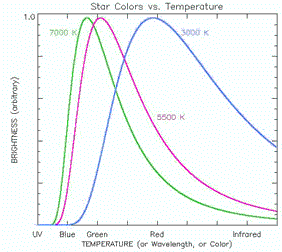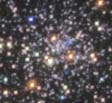
| Bad Astronomy |
|
|
|
BA Blog
|
|
Q & BA
|
|
Bulletin Board
|
| Media |
|
|
|
Bitesize Astronomy
|
|
Bad Astro Store
|
|
Mad Science
|
|
Fun Stuff
|
| Site Info |
|
|
|
Links
|
| RELATED SITES |
| - Universe Today |
| - APOD |
| - The Nine Planets |
| - Mystery Investigators |
| - Slacker Astronomy |
| - Skepticality |
Buy My Stuff

Keep Bad Astronomy close to your heart, and help make me
filthy rich. Hey, it's either this or one of those really
irritating PayPal donation buttons here.
All Stars are White
Bad Astronomy: All stars that you can see at night are white.Good Astronomy: Stars actually emit all the colors of the rainbow. Literally!
I have had a couple of people email me and suggest this as a Bad Astronomy topic. I don't think it's Bad, so much as Not Really Thought About. Most people don't really think about stars having colors, so they tacitly assume all stars are white. But look at the Sun! It looks yellow to me, and it's a star!
This one is easy to disprove by yourself. Go outside on a clear night and look at the stars. The best ones to look at are the brightest. In the Summer, (for the Northern Hemisphere) Vega is a bright star high overhead, and is clearly blue. Antares is another summer star and is also clearly red (or orange). In the Winter, you can see Betelgeuse in the constellation of Orion, which is very red. Aldebaren, a star in Taurus (near Orion) is also very red.
But most of the dimmer stars really do look white. What's going on here?
First off, stars really do have all different colors. Back in the 19th century (and before) it was known that when you heat an object up, it glows, and furthermore the color of the glow depends on the temperature of the object. A man named Wien (pronounced "Veen"; he was German) was even able to apply some math to this and calculate the temperature of an object given its color, although just why this worked was unknown. It wasn't until the 20th century that this was understood, when another scientist named Planck helped develop quantum mechanics.
Mind you, this only works for objects that are glowing, and therefore giving off their own light, and not objects that are simply reflecting light.
Color is just another word for wavelength; light behaves like a wave, and the color of the light depends on the wavelength. Planck worked out a mathematical relation of temperature, color and brightness of a freely glowing object. He found, as Wien did, that an object at a given temperature will emit most of its light at a certain wavelength, and less at all other wavelengths. When you plot up the brightness of an object versus the wavelength (or color), you get a curve now called a "Planck curve", or a "blackbody curve", because it represents a black object heated up. The plot below shows three such curves scaled so that the peak brightness are the same. See how the hottest one (at 7000 degrees Kelvin, a temperature scale much like Centigrade) peaks at a wavelength that is blue, and the cooler one (at 3000 K) at red? The one in between (5500 K) peaks in the green. [Note(added September 29, 2000): the graphic below is a bit confusing. The original colors of the plots matched the stars I discuss in the text, but somehow got messed up when put on the page. I'll fix this when I get a chance. Sorry about the confusion!]

This is why stars are different colors: they have different temperatures! Vega is a very hot star, and so it glows blue. Betelgeuse is much cooler, and so it looks red. I will point out here that stars are really not blackbodies, and some deviate substantially from being so. They absorb light, taking light from one part of the spectrum and re-radiate it at another. These curves are only approximations. The Sun, for example, should peak at about 5000 Angstroms or so, having a surface temperature of 5500 K. However, due to complicated processes, it actually peaks bluer than that, around 4800 Angstroms (a solar spectrum plot can be found here). Oddly, when you mix all the colors of sunlight, you get white. It may peak in the blue, but the combination of colors (and the way our eye interprets them) makes us perceive this light as white. Many people claim the Sun looks yellow to them. I am not sure why, and have never found an adequate explanation. Is it contrast with the blue sky? I don't know.
So, back to the original question: why do so many stars look white? Are most of them like the Sun?
Nope. Oddly, the vast majority of stars in the sky are cool, red stars, usually too dim to see. The reason most stars appear white to us is because we have two different kind of light sensors in our eyes. Sensors called "rods" detect brightness, while sensors called "cones" detect color. The cones are not very sensitive, so if a light is too dim they are not activated, and we perceive the color as white. So even a red star looks white if it is dim, and only brighter stars look like they have color to us!
If you have a pair of binoculars, look at some stars that are bright but still look white to your naked eye. You'll find that lots of them through the binoculars suddenly have color! The binoculars focus more light into your eye, and for brighter stars there will be enough light to activate the cones in your eye. A telescope will show even more stars with colors. There is a star, named Albireo, that to the naked eye looks like one star, but is actually two in close orbit around each other. One of the stars is a striking red, while the other a brilliant blue. Through even a modest telescope this is one of the most beautiful sights in the sky.

Here is a small portion of a Hubble Space Telescope image of stars in a globular cluster (called M15), a huge collection of about a million stars in a ball shape that orbits our own Milky Way. The stars here are all at about the same distance, so any difference in brightness is really intrinsic to the stars. Note that some stars are red, some yellow, some white and some are blue. In this image if a star looks white it really is white; even a dim red star will look red. It's possible that the faint white stars in this image are all burned out stars, like the way the Sun will be in a few billion years. Note that this image is not really true color, but very close. It is very difficult to get true color photographs of astronomical objects. For the complete image and a description, click here to go to the Space Telescope Science Institute's HST image page!
There's no substitute for simply proving something to yourself. Go outside and look at the sky! And if you see a meteor, make a wish on it that all astronomy turns out to be Good Astronomy.
You can see this for yourself. On the web is a very cool Java applet that allows you to adjust the temperature of a star. As you do, you see the blackbody curve change, as well as the spectrum and color of the star. This applet can give you more of a feel of what I am saying here. Another good one can be found at Mike Lee's page, who wrote the applet as an undergrad student at Davidson College.
Thanks to Bryan Gaensler for this Bad Idea, and to Dave Joiner (of CSERD) for sending me his blackbody applet URL!
|
|
|
|